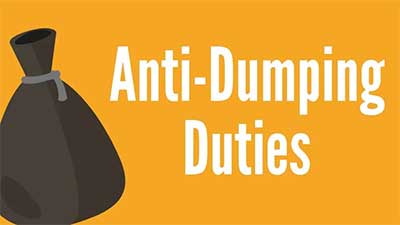GS-3: Effects of liberalization on the economy, Government Policies & Interventions.
Keywords: Anti-dumping duty, DGTR, countervailing duty, safeguard measure, WTO, GATT
Why in News:
The Finance Ministry has imposed definitive anti-dumping duty on certain flat-rolled products of aluminium (FRPA) from China.
What is Anti-dumping duty?
- An anti-dumping duty is a protectionist tariff that a domestic government imposes on foreign imports that it believes are priced below fair market value. Dumping is a process wherein a company exports a product at a price that is significantly lower than the price it normally charges in its home (or it’s domestic) market.
Who imposes it?
- Directorate General of Trade Remedies (DGTR) recommend Finance ministry for imposing the Anti-dumping duty on certain goods.
- However, the Ministry of Finance takes the final call to impose these duties and issues notification for Anti-dumping duty.
- The Directorate General of Trade Remedies (earlier known as Directorate General of Anti-dumping and Allied Duties) was named in May 2018 as an integrated single window agency for providing comprehensive and swift trade defence mechanism in India.
- DGTR functions as an attached office of Department of Commerce, Ministry of Commerce and Industry.
- DGTR now deals with Anti-dumping, CVD and Safeguard measures.
What is its objective?
- The purpose of anti-dumping duty is to rectify the trade distortive effect of dumping and re-establish fair trade.
- In the long-term, anti-dumping duties can reduce the international competition of domestic companies producing similar goods.
Does WTO have any provision on Anti-dumping duty?
The WTO agreements uphold the principles of equality for the smooth flow of trade in goods, but they also allow exceptions — in some circumstances. Three of these issues are:
- Actions taken against dumping (selling at an unfairly low price)
- Subsidies and special “countervailing” duties to offset the subsidies
- Emergency measures to limit imports temporarily, designed to “safeguard” domestic industries.
- The legal definitions are more precise, but broadly speaking the WTO agreement allows governments to act against dumping where there is genuine (“material”) injury to the competing domestic industry. In order to do that the government has to be able to show that dumping is taking place, calculate the extent of dumping (how much lower the export price is compared to the exporter’s home market price), and show that the dumping is causing injury or threatening to do so.
- GATT (Article 6) allows countries to take action against dumping. They allow countries to act in a way that would normally break the GATT principles of binding a tariff and not discriminating between trading partners. Typically anti-dumping action means charging extra import duty on the particular product from the particular exporting country in order to bring its price closer to the “normal value” or to remove the injury to domestic industry in the importing country.
- Anti-dumping measures must expire five years after the date of imposition, unless an investigation shows that ending the measure would lead to injury.
|
Anti-dumping duty
|
Countervailing duties
|
Safeguard measure
|
- GATT was an international trade agreement came into effect on January 1, 1948.
- The purpose of GATT was to liberalise trade by reducing tariffs and reducing quotas among member countries.
- GATT was replaced by WTO in 1995.
Source: The Hindu BL
Mains question:
Q. What is Anti-dumping Duty? Discuss several provisions of WTO rules for protecting trade in domestic country.







